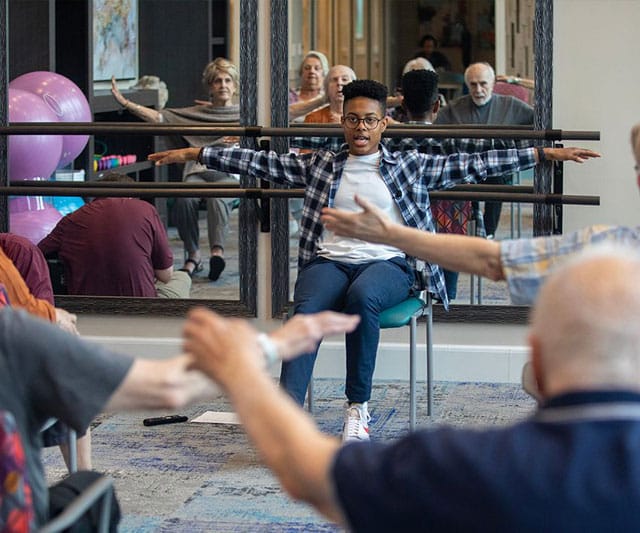Exercises custom tailored for Parkinson’s patients are benefitting them physically, mentally and emotionally, according to experts in the field.
“Evidence is really mounting that exercise is helping Parkinson’s patients,” says Pritha Ghosh, a physician, neurologist, volunteer chairperson of the Medical Advisory Board of The Parkinson Foundation of the National Capital Area (PFNCA) and a PFNCA board member. “I recommend exercise for 100% of Parkinson’s patients.”

Ghosh says studies in mice have shown that exercise increases production of brain chemicals that support neurons and help prevent brain cell degeneration, one of the most pervasive manifestations of Parkinson’s. (Typically, researchers create lesions in mice to mimic the symptoms of Parkinson’s since the disease does not naturally occur in rodents.)
In addition, studies on Parkinson’s patients show that exercise promotes new connections between different parts of the brain that serve as detours when the effects of the disease block regular paths, Ghosh says.
“Exercise can have a neuro-protective effect that medication for Parkinson’s doesn’t have,” she says.
Growing awareness
Ghosh, also an associate professor of neurology and assistant dean of student affairs at George Washington University in Washington, D.C., says it appears that during the past decade, the news of the studies seems to have spread among healthcare professionals working in the field, leading to more Parkinson’s patients exercising.
Parkinson’s Disease is a chronic neurologic condition named after Dr. James Parkinson, who first described the syndrome in 1817, according to the PFNCA website. It’s a slowly progressive disease, which causes a gradual loss of the nerve cells in the brain that produce the neurotransmitter dopamine.
Because dopamine carries signals to the part of the brain that control movement and coordination, decreased dopamine levels lead to symptoms such as tremors, insufficient balance, falls, slowness, stiffness of limbs, dementia and more. Handwriting often becomes smaller. Impacts vary widely, with many symptoms occurring in some patients but not others.
The exercises for Parkinson’s patients are designed to improve posture, balance and circulation and increase strength, muscle control and mobility, cognitive skills and emotional well being, according to the website.
Getting started
Ghosh says it’s important for patients to consult with doctors and fitness instructors specializing in exercises for Parkinson’s patients. These experts can custom tailor exercise routines that suit their symptoms, physical needs and abilities. For example, she says, a patient with balance problems should not ride a regular bicycle.
Repetition of exercises will yield better results, just as a budding pianist will only improve through regular practice, Ghosh says. She adds that in addition to exercise helping physically, it also helps with cognitive skills. As participants listen to and follow instructions from a fitness instructor and the activity sends more blood to the brain, which helps it function better.
Exercise also improves the quality of sleep and helps patients feel better emotionally as well as physically, she says. They enjoy a sense of accomplishment from participating in the exercise classes, have social engagement with other participants, feel less alone and are more likely to stay motivated.
Ghosh acknowledges that some people with Parkinson’s, like many who do not have the disease, simply do not want to exercise. This can happen for a variety of reasons including depression (which can be caused or exacerbated by Parkinson’s), apathy, lack of motivation, lack of transportation to get to classes, or not feeling comfortable using computers to log into virtual classes, she says.
In those cases, health professionals can try to motivate patients to take small steps, such as encouraging those who can walk to do so for ten minutes three times a week and then gradually increase the length of time, Ghosh says.
A program in motion
PFNCA partners with The Providence, an assisted living facility in Fairfax, Va., to offer exercise classes for individuals with Parkinson’s. Charity Hammond, The Providence’s wellness coordinator, designed and teaches the classes. The exercises she incorporates include big, exaggerated movements to preserve a full range of motion, improve cognitive function and maintain strong vocal capabilities. Hammond sits while instructing patients who have trouble standing how they can stretch and engage in other movements, including yoga, from their chairs. Sitting with participants is important because she is meeting them at their level.

Ed Sofinowski, who lives at The Providence, is a regular, even attending one recent class just after a fall. He says he did not injure himself when he landed on his side on carpeting at The Providence, still wanted to exercise and was glad he did.
“The exercise helped me get through the fall,” he says.
Sofinowski, 68, says he also takes boxing classes, walks with a rollator, does aquatic walking (in a pool) and practices Tai Chi, which involves slow, gentle movements.
Sofinowski says it’s too early to know how much the Parkinson’s exercise class has helped him in general, since he also does other types of exercise. “But I feel positive about it and I think it will help. Charity has a calmness, she encourages you.”
Brain boosts and multiple options
Hammond says the class helps patients cognitively, too.
“We also do a lot of opposite leg, opposite arm movements, which not only helps with mobility but improves cognitive function,” she says. “Another activity aimed at improving cognitive function is to have them count backwards by two’s as we repeat exercise motions, or have them name different models of cars, or repeat the exercise commands with me in a loud voice. People with Parkinson’s have limited motion and mobility or are wheelchair-bound. When they lose mobility, their voice gets smaller. So we work on that, too.”
Hammond’s classes include participants who exercise on varying levels, so she always gives them two options on how to do an exercise. “I tell them do what makes them feel comfortable and I make sure everyone can do it,” she says. And she never says “no pain, no gain.” (Hammond emphasizes that should never be any sort of mantra or guiding principle for any exercise routine, even for those who are young, healthy and highly, physically functional.)
The classes, started in early December and held three times per week, are free to Providence residents and the public. Six to seven participants usually attend, Hammond says.
The classes also have mental and emotional benefits, she says. “Exercise releases endorphins. That makes people happy.”
From wheelchair to walker
One of The Providence residents visible improved since starting the classes previously required a wheelchair and could only walk minimally, lacking balance. “Now he walks, with a walker, from his building to the class in the next building,” Hammond says. She notes that his participation in a weekly boxing class and medication could also be helping.
Parkinson’s research is continuing, with studies showing some promising, potential new medications, says Ghosh.
For more information about Parkinson’s, the benefits of exercise and other resources for patients and their families, visit the Parkinson Foundation website.
Denise DiStephan is an award-winning, veteran journalist and communications professional based in New Jersey.







